The Summer of Women
Begins May 14 at Frost Art Museum FIU
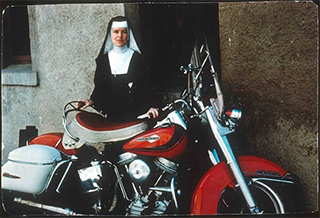
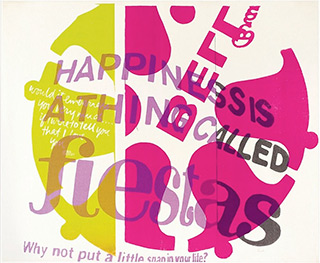
First-off is a fresh look at the artwork of rebel-nun/Pop Art pioneer Corita Kent. The exhibition, titled In the Beginning was the Word: Works by Corita Kent, ushers in The Summer of Women and will be on view through September 18. Originating at the Frost Art Museum FIU, the exhibition presents a collection of fifty works bursting with color and meaningful text, selected to showcase the artist’s Pop Art legacy and memorable calls-to-action for social justice.
 In the beginning was the Word celebrates Corita’s fusing of iconic quotes from popular culture with spiritual texts and American consumerism brand iconography from the 1960s and 1970s (including street signs, product packaging, ad slogans, song lyrics and billboards).
In the beginning was the Word celebrates Corita’s fusing of iconic quotes from popular culture with spiritual texts and American consumerism brand iconography from the 1960s and 1970s (including street signs, product packaging, ad slogans, song lyrics and billboards).
Corita Kent – also known in the 1960s as Sister Mary Corita – embedded her art with messages driven by her passions for world peace, civil rights, spirituality, dissent and anti-war activism. She helped spearhead the establishment of silkscreen (serigraphy) as a fine art medium and expanded the cultural terrain with her artful “happenings” and rebellious art-activism. Corita is also recognized historically as a pioneer in art education, a feminist, and an influential designer (the American Institute of Graphic Arts lauded her as a 2016 Medalist). In recent years she has gained overdue recognition for her role in the Pop Art Movement.
The Frost Art Museum’s Director, Dr. Jordana Pomeroy, says, “Recently the world has begun to grant Corita Kent the recognition she deserves, including the first full-scale survey of her work last year at the Andy Warhol Museum, prominent exhibitions at the National Museum of Women in the Arts and the Harvard Art Museums, and an upcoming exhibition at the Victoria and Albert Museum in London.” “Her works reflect the activist ethos of the time and express her concerns about racism, poverty, and the Vietnam War. As a professor of art at the Immaculate Heart College in LosAngeles – and a modern nun – she saw her calling to use art as a response to cultural discord and shifts in public sentiment. Corita Kent’s legacy as a Sister who sought to awaken social consciousness in the United States is exemplified by her dynamic colorful prints that continue to provoke discussion and promulgate sentiments about social iniquities that still exist in our society, half a century after their creation,” adds Dr. Pomeroy.
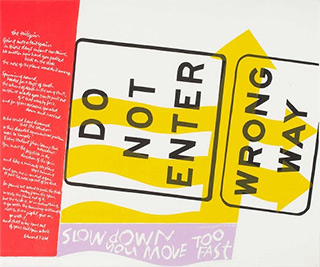
She elevated silkscreen printing to fine art and through her work was able to communicate the spiritual resonance of ordinary objects such as traffic signs warning “WRONG WAY” and “DO NOT ENTER,” popular magazine and television advertisements for soda, tomato sauce and potato chips, and song lyrics from Top 40 hits.
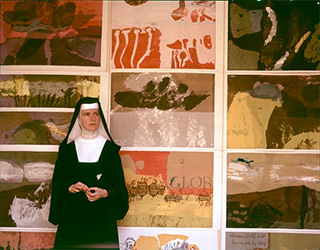 Corita championed tirelessly against the Vietnam War through her art, and her cries for peace were not always welcome. She was moved to action by the changes brought forth by the Second Vatican Council of the Roman Catholic Church (the artist was featured on the cover of Newsweek Magazine in 1967 with the headline “The Nun: Going Modern”) and she challenged her superiors at her local Archdiocese.
Corita championed tirelessly against the Vietnam War through her art, and her cries for peace were not always welcome. She was moved to action by the changes brought forth by the Second Vatican Council of the Roman Catholic Church (the artist was featured on the cover of Newsweek Magazine in 1967 with the headline “The Nun: Going Modern”) and she challenged her superiors at her local Archdiocese.
After mounting pressures from her Cardinal, she left Los Angeles and the Order in 1968 and moved to Boston where she decided to devote her life entirely to making art.
Her most prolific period occurred during the 1970s and 1980s, when she also struggled with cancer several times. This time-period included Corita’s famous 150-foot high “Rainbow Swash” (the world’s largest copyrighted work of art, considered one of Boston’s major landmarks), controversial because many believed the artist embedded a profile of Vietnamese leader Ho Chi Minh to protest the Vietnam War.
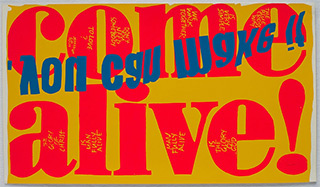
She never strayed from her dedication to social activism, creating posters and billboards for charitable organizations such as Physicians for Social Responsibility, The International Walk for Hunger and Amnesty International. Corita died in 1986 from cancer.
Although part of the Pop Art canon, Corita’s work was excluded from male-dominated Pop Art surveys during its heyday and subsequent years. Her recognition paled dramatically to her male contemporaries (including Warhol and Ruscha), and until recently, her work had been overlooked. In 2013, the Warhol Foundation presented the first full- scale survey of her work covering over 30 years of her artistic career. The upcoming group exhibition at the Victoria and Albert Museum in London features Corita Kent’s artwork and is titled “You Say You Want a Revolution? Records & Rebels 1966-1970: How have the finished and unfinished revolutions of the late 1960s changed the way we live today and think about the future?”
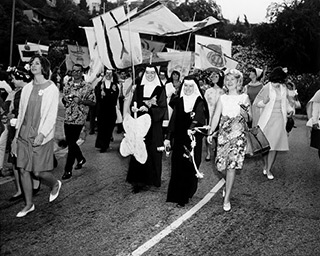 Corita Kent’s work can be found in several art museums and private collections including the Whitney, the Museum of Fine Arts in Boston and New York’s Metropolitan Museum.
Corita Kent’s work can be found in several art museums and private collections including the Whitney, the Museum of Fine Arts in Boston and New York’s Metropolitan Museum.
The Summer of Women includes two other exhibitions: Suddenly Last Summer also opens May 14 and features new works by South Florida-based artists Leah Brown, Donna Hayes and Michelle Weinberg, curated by Adrienne Rose Gionta. Each artist has been given a room to create site-specific installations inspired by the hit song by The Motels.
On June 18, the museum debuts Resonance/Dissonance, curated by Klaudio Rodriguez and featuring the works of women video artists from the de la Cruz Collection including Susanne Wintering, Sarah Morris, Tracey Emin, Aida Ruilova, Dara Friedman and Beatriz Monteavaro.


